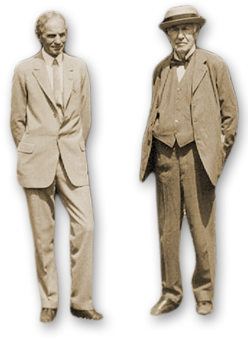The Edisons and the Caloosahatchee
June 10, 2024
By Alice Rolston, Curatorial Assistant
The original location for the fort that would become Fort Myers was selected due to its prime location on the Caloosahatchee. The river was originally a shallow and meandering body of water that offered an inlet to the rest of the state during the Seminole wars. Before dredging and the implementation of a dam and lock system, the river experienced extreme cyclical variations in stream flow. In the dry season, the river would become too shallow for boats to traverse. In the rainy season, the river flooded the settlements that depended on it the rest of the year.
From 1881 to 1965, several projects were undertaken to limit flooding, improve ease of navigation, and to prevent salt water from contaminating freshwater aquifers. The first of these projects started in September 1881, when industrialist and real estate developer Hamilton Disston brought a dredge into downtown Ft. Myers. He had a 48- foot canal dredged from Ft. Thompson (1 and a ¼ mile east of LaBelle) to Lake Okeechobee. Since the Disston Dredge was the only intentional change made to the river when Thomas Edison first visited in 1885, the Edisons enjoyed the Caloosahatchee in its more natural state.
Edison’s first view of Fort Myers came by boat 12 miles upriver from Punta Rassa. He was astounded by the beauty of the river with rookeries full of tropical birds and massive alligators sunning on the shores. Edison didn’t just fall in love with the river but also the small frontier outpost that was Fort Myers. He purchased 13 acres along the Caloosahatchee for $2,750, a mile and a half from downtown.
When the Edisons stayed in Fort Myers, they took many excursions out on the river. The Edisons chartered local guides or took out their own boats to cruise the river. Throughout their stays, the Edisons traveled by boat to scenic locations such as Fort Thompson, Captiva Pass, Lake Okeechobee, and Sanibel Island on several occasions.
Thomas Edison had two boats brought to his Fort Myers estate for better enjoyment of the Caloosahatchee. The first was “The Mina” in 1903. Named after Mr. Edison’s second wife, it was a 25-foot, gasoline engine boat with electric lights powered by Edison Storage Batteries. In 1903, the Edisons took “The Mina” on a fishing expedition to Four Mile Island, a mangrove formation in the Caloosahatchee River, that serves as a rookery.
The second boat that Edison brought to his Fort Myers estate was the “Reliance.” It was a 36-foot electric launch that Thomas Edison purchased in 1904 from the Electric Launch Company. His new boat was powered by Edison Storage Batteries that were charged on the dock at the Edisons’ boat house.
Captain Fred Menge and brother Captain Conrad Menge were local guides who chartered the Edison family on their river cruises. In 1902, the captains named their new steamer after the inventor. The “Thomas A. Edison” was an 89-foot stern-wheel boat that quickly became a tourist attraction. The Menge brothers owned the Caloosahatchee River Steamboat Line which included the “Thomas A. Edison” as well as five other vessels.
In 1906, Mina Edison was worried about her children missing weeks of school to vacation in Florida. To bring her children’s education with them, she coordinated with Madeline Edison’s school, Oak Place School, for a class trip to Florida for Madeline and four other girls. During the class trip, the Edison family hosted a five-day trip up the Caloosahatchee on one of Captain Menge’s steamships, Suwanee, to learn about local wildlife. Mina gave the girls a birding lesson.
Mina loved birding and the river front was perfect for observing species that could not be seen at Edison’s home in New Jersey. She would often sit on the porch of Seminole Lodge to watch Ibises, Long-Billed Curlews, Everglades Snail Kites, Herons, and Bitterns. She had birdhouses installed over the river to attract Purple Martins.
The Edison family enjoyed many of the same activities that continue to bring people to Fort Myers today. Thomas Edison loved fishing on the Caloosahatchee, so much so that in 1912, Mina wrote to the US Department of Fisheries regarding restocking the river with fish so that her husband could continue to enjoy the hobby without depleting the fish population. Fishing was so important to the Edison family that Madeline’s first rule for guests visiting Seminole lodge was, “Don’t cabbage unto yourself all the fishing poles – This has been done by guests incurring the grave disapproval of the entire family.” Another one of Madeline’s rules was, “Don’t make the mistake of thinking you’d like to catch a Tarpon. You wouldn’t. Mother and father have both been after one with blood in their eyes – and there are just four poles,” demonstrating in a humorous way that the Edisons were rather serious about fishing.
The Edison family also enjoyed hunting for shells when they came to Fort Myers. Our museum collection includes a very extensive collection of Mina Edison’s shells that she had gathered over the years with her family. Included in her shell collection are figurines that she crafted out of the shells collected by her family. Some of the figurines depict Florida wildlife such as Ibises and tortoises.
The river and City of Fort Myers was a tropical getaway to Edison; a place where he and his family could put aside their worries and enjoy the beauty that nature had to offer. Today, the Caloosahatchee is vital to Fort Myers, not just in its historical context, but its cypress and mangrove formations still host rookeries where thousands of birds meet to breed each season. Local guides still give boat tours of the river. Visitors come from all over the world to enjoy the Caloosahatchee in the same ways that the Edisons did more than one hundred years ago.


